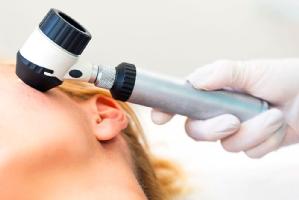
Hives
Author: Nicole Marty, MD
What do hives look like?
Hives are raised, red areas that are very itchy. They may sometimes have a pale center. They can vary from ½ across to several inches across and the shapes and location of the hives can change frequently and quickly. The most common cause of hives is children is a viral infection.

My child has hives, do I need to take them to the emergency department right away?
Most of the time, hives, while bothersome, are not an emergency. If your child has a minor case of hives but is otherwise completely well you can watch your child at home. However, if your child has any of the following along with hives, you need to call 911 now:
- Trouble breathing or wheezing
- Trouble swallowing, drooling or slurred speech
- Hoarse voice or a cough that started suddenly
- Exposure to a substance which caused anaphylaxis in your child in the past
- You think that your child may have a life-threatening emergency
Your child should be seen on an urgent basis in his or her doctor's office, urgent care or emergency department if you see the following:
- Hives that start after eating nuts, fish, shellfish or eggs
- Hives which start after taking a medication
- Hives all over the body in a child under the age of 1
- Hives are accompanied by stomach pain or vomiting
- Your child has joint pain or swelling of the joints
- Hives are severe (especially on the face)
- If your child looks or acts very sick
Call your doctor's office during regular business hours if:
- Hives are bothersome and taking Benadryl for 24 hours has not helped
- Hives have lasted more than 1 week
- Your child has had hives 3 or more times and the cause is not known
What can I do to help my child feel better?
If the hives are on just one part of the body, that is usually caused by skin contact with an irritating substance. Hives on one part of the body usually go away on their own in a few hours and do not require Benadryl. The hives should go away in a few hours.
If your child has hives all over his or her body and is older than 1 year of age you can use Benadryl 4 times per day (up to every 4 hours) until the hives are gone for 12 hours. You can find a dosing chart on our after hours page under "helpful documents and links". You can also put your child in a cool bath for 10 minutes a few times per day to help with itching. You can also rub an ice cube on itchy spots for a few minutes to help decrease itching. Try to wear loose-fitting, cotton clothing.
What should I expect if my child has hives?
If the hives are caused by a viral illness, they will usually last 3-5 days and may come and go over that time. If the hives are caused by an exposure to an allergen, your child is likely to have hives each time he or she is exposed to that allergen, so it is best to avoid it completely. Sometimes, hives caused by food may appear just around the mouth, these should resolve in a short time (often less than 5-6 hours). If hives around the mouth are causing difficulty breathing or swallowing, you need to call 911 now.

Related Articles

Dermatology
What Is Melanoma?
Melanoma is a dangerous type of skin cancer with the ability to rapidly spread to other organs if...

Dermatology
Mohs Surgery
Mohs micrographic surgery is considered the most effective technique for treating many basal cell...

Pediatric Medicine
Strep/Sore Throat
My child has a sore throat, how do I know if it is strep throat? It is important to remember that...

Pediatric Medicine
Fever FAQ
Most of the time, fever is not a medical emergency and can wait until the next morning to be seen in...
